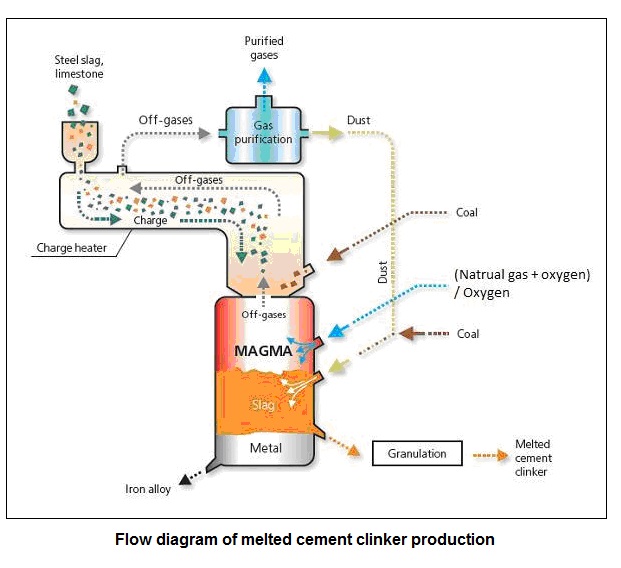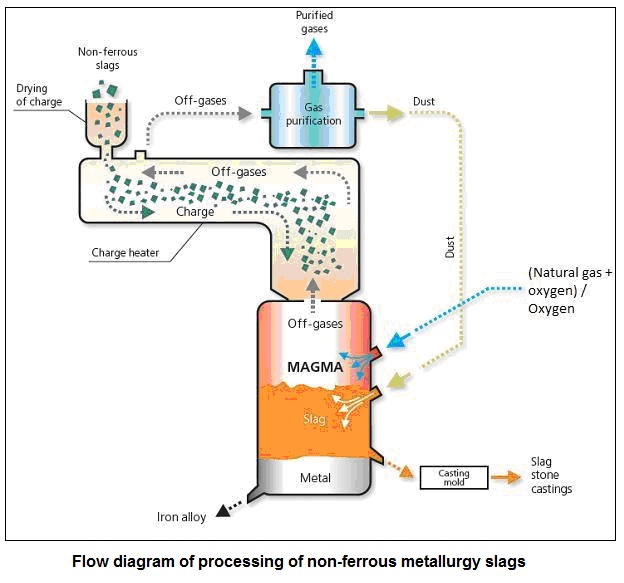Processing of steel slags of ferrous & non-ferrous metallurgy in MAGMA
Production of cement can be increased by increase of extraction of natural resources and construction of new plants for processing these natural resources. However, this is a costly and environmentally detrimental method.
At the same time, waste of ferrous metallurgy contains an enormous amount of oxidized steel slags with a high basicity.
After meltdown of such slags in the smelting unit MAGMA and partial reduction by carbon of oxides contained in them by process route shown below (Fig. 4), we get molten slag (molten clinker) similar by its chemical composition to cement clinker manufactured by conventional methods at existing cement plants (Table 1 below).
 Chemical composition of oxidized steel slag, cement clinker and Portland cement type СЕМ1-
Chemical composition of oxidized steel slag, cement clinker and Portland cement type СЕМ1-
Table 1
| Material | content, % | |||||||
| Cao | Al2o3 | Sio2 | Mgo | Fe2o3 | Mno | Fe, prills | So3 | |
| Oxidized steel slag |
40-55 |
1.5-3 |
15-19 |
1.5-2.5 |
18-25 |
4-7 |
4-6 |
— |
| Slag smelted and partially reduced in MAGMA |
61.7-63 |
1.8-3.7 |
18-24 |
1.8-3.1 |
4.5-5.2 |
2.5-4 |
0 |
— |
| Conventional cement clinker |
60-67 |
3-8 |
17-25 |
2.5-5 |
4-5 |
— |
0 |
— |
| Typical Portland cement type СЕМ 1 |
62-64 |
5.5 |
21.5 |
1.5 |
3-4 |
— |
0 |
1.9 |
Production capacity of MAGMA for clinker is 200,000-400,000 tons per year and depends on chemical composition and the temperature of the slag being processed.
Up to 800 kg of melted cement clinker and up 250 kg of iron alloy can be produced out of 1 ton of re-smelted steel slag.This allows to significantly reducing the costs of production of the melted clinker.
Production of melted cement clinker out of ferrous metallurgy waste allows decreasing the environmental impact due to refusal from the use of natural resources, reducing energy intensity of production and CO2 emissions per ton of products, i.e., achieve a significant environmental improvement (Flow diagram & Table 2 below).

Conventional method of Clinker production
- Pit (Limestone, clay)
- Transport
- Crushing
- Pre-homogenizing
- Grinding
- Gas purification
- Preliminary roasting
- Rotary kiln
- Cooling
Production of Portland cement
- Warehouse of clinker
- Additives
- Grinding of Portland Cement
- Cement silo, shipment
Production of Melted clinker
- Slag dump
- Transport
- Warehouse, charge heating
- MAGMA Unit
- Granulator
- Gas purification
- Oxygen Station
Comparative figures of cement clinker production methods-
Table 2
| Production method | Raw materials | Saleable products | Energy carriers used | Specific units per 1 ton of product | ||||
| Limestone consumption | Natural gas consumption | Coal consumption | Off-gases volume | СО2 emissions | ||||
| kg | m3 | kg | kg | kg | ||||
| Conventional method | Natural resources (clay, limestone) | Cement clinker | Natural gas, electric power |
1150-1850 |
82-96 |
— |
1500-1700 |
720-840 |
| MAGMA method (range of given figures depends on slag composition) | Ferrous metallurgy waste (oxidized steel slags, scales, gas treatment dust) | Cement clinker, iron alloy | Natural gas, electric power, coal |
50-570 |
60-70 |
70-110 |
520-930 |
290-615 |
PROCESSING OF SLAGS OF NON-FERROUS METALLURGY
Leading scientific centers of Russia conducted researches that showed efficiency of use of liquid slags for production of cast slag products: parts of tunnel lining, weighting material for pipe-lines, products for chemical, metallurgical and construction industries.
Best quality is achieved in slag castings made out of low basicity (acidic slags) with high content of iron oxides (Table 3).
Such chemical compositions are characteristic of the slags from non-ferrous metallurgical plants that produce nickel and copper and for the slags of thermal power stations that work on thermal brown coal (Table 4).
Properties of cast slag products – Table 3
| Parameter | Unit | Value |
| Volume weight | kg/m3 | 2900-3000 |
| Ultimate compression strength | Mpa | 200-500 |
| Ultimate bending strength | Mpa | 15-50 |
| Impact strength | kJ/m2 | 1.06-1.25 |
| Elasticity modulus | Mpa | (0.43-1.01)∙105 |
| Poisson number | — | 0.25 |
| Thermal resistance | 0c | 200-600 |
| Thermal conductivity at 20°C | W/(m∙0c) | 1.07-1.52 |
| specific heat capacity at 20°C | kJ/(kg∙0c) | 0.67-0.85 |
| Temperature coefficient of linear expansion within interval 20-600°C | 0 | -5 |
| Abrasion coefficient | kg/m2 | 0.1-0.2 |
| Water absorption | % | 0.03-0.1 |
| Freeze resistance | cycles | over 300 |
| Acid resistance in 20% hydrochloric acid | % | upto 97.8 |
| Acid resistance in concentrated sulphuric acid | % | up to 99.7 |
| Alkali resistance in 35%alkali | % | up to 98.6 |
| Diffusion coefficient of sr and cs ions:
-att=25°C -att=600°C |
cm2/s |
~10-18 ~10-14 |
Average compositions of slags from non- ferrous metallurgy and thermal power plants- Table 4
|
Type of slag |
Content, % | Melting temperature,°C | ||||||||||
| Sio2 | FeO | CaO | Al2o3 | Mgo | Cu | Co | Ni | Zn | Pb | S | ||
| Copper smelter slags | 32-45 | 25-45 | 12 | 3.2-9.7 | 2-11 | 0.3-0.9 | — | — | 0.5-1 | 0.22-0.8 | 0.4-1.2 | 1100-1150 |
| Nickel shaft furnace slags | 39-45 | 16-24 | 12-21 | 4.5-7.5 | 9-17 | — | 0.010-
0.024 |
0.1-0.17 | — | — | 0.43-
0.5 |
1100-1200 |
| Nickel basic oxygen furnace slags | 25-35 | 40-60 | 2-3 | 3-10 | 2-4 | 0.1-0.2 | 0.01-
0.02 |
0.3-0.7 | — | — | 2-3 | 1100-1200 |
| Ash of thermal power plants working on brown coal | 54-55 | 2.5-10 | 1.6-2.5 | 24.7-25.2 | 2.5-2.6 | — | — | — | — | — | 0.1-0.3 | 1400 |
| Average composition of slag castings | 44-49 | 7-20 | 6-16 | 9-20 | 5-13 | — | — | — | — | — | — | 1300-1350 |
These waste, which have relatively low melting temperature, are annually produced in large amounts and are accumulated in dumps.
MAGMA allows to economically smelt slags of non-ferrous metallurgy and thermal power plants with adjustment of chemical composition and temperature of molten mass in the process of re- smelting.
Furthermore, the metal component present in slags of non-ferrous metallurgy is extracted from it and is used as additional saleable product.
The gas treatment system of the unit can capture zinc and lead contained in the slags being re-smelted.
As a result, production costs of slag castings can be significantly reduced through the sale of additionally produced metal.
MAGMA has better technical performance than slag-smelting units conventionally operated in the industry (Table 5).
MAGMA has still more effective performance in case of using hot liquid slags fed into the smelting chamber of the unit directly from metallurgical furnaces.
In this case,the unit will be also used for leaning of slags of non- ferrous metallurgy.
Comparison of performance of slag-smelting units –
Table 5
|
Type of slag-smelting unit |
Production capacity for smelted charge | Fuel consumption per 1 ton of charge | Consumption of blowing per 1 ton of charge | Temperature of slag | |
| Tons/hour | Absolute units | MJ | m3 | °C | |
| Smelting unit MAGMA | up to 50 | natural gas 70-82 m3 | 2600-3000 |
oxygen 157-182 |
1400-1650 |
| Arc stationary furnace with water cooling of the unit body (limestone-alumina slag) | 2.5 – 3 | electric power 1500 kWh | 5400 | — | 1650-1700 |
| Regenerative tank furnace for production of mineral molten mass | 3 | natural gas 200 m3 | 7340 | air 3700 | 1380 |

